The Eloquence of Herr Martin Tolmaque
Chapter Three - Touring Performer 1865 - 1874
In the season 1864, and a portion of 1865, I was engaged in fretting and strutting my hour upon the Liverpool stage. Farce, comedy, tragedy, all came alike to my lot, and no small share of my knowledge of English owes its origin to this engagement. I had to study nil you, will you! But the great Shakespeare has taught us that – ‘The labour we delight in physics pain.’ - ‘The Struggles of Life’, Chapter IV
Herr Tolmaque drops from sight for much of the rest of 1865, though we have his memoir to indicate what was happening:
[Chapter XX] “At the conclusion of this [Liverpool] engagement I made fresh terms with the manager to remain as a regular member of his company, making my first appearance at the Theatre Royal with that great comedian, Charles Mathews. Here I remained for two seasons playing with nearly all the great stars of the day - Bateman, Fechter, Dillon, and many other London celebrities.
Eventually I started a company of my own, travelling the provinces and playing for a week or two in each place. This, with my country entertainment, which I gave between the pieces, proved too hard work and the end, another severe illness overtook me. On my recovery I found that I had sustained the most severe loss and actor can possibly feel, namely the partial loss of ‘study’; and although I could distinctly recollect any part I had studied prior to my illness, I could not manage to study a fresh part.”
Given his later medical history, this loss of short-term memory may have been a precursor of cognitive decline in the years to come. Martin mentions a number of occasions on which he became seriously ill, though it is almost impossible to connect those to any known date.
From a lengthy advertisement published in ‘The Era’ on February 4, 1866 we can see that Tolmaque was re-entering the field of magic after this extended period of working as an actor. He mentions Mr William Robert Copeland, an actor/manager of the Theatre Royal and the Royal Amphitheatre in Liverpool (Copeland died in May 1867), and in using the words ‘ten months First Walking Gentleman’ Martin indicates that he was not playing lead parts, but a stock ensemble character.
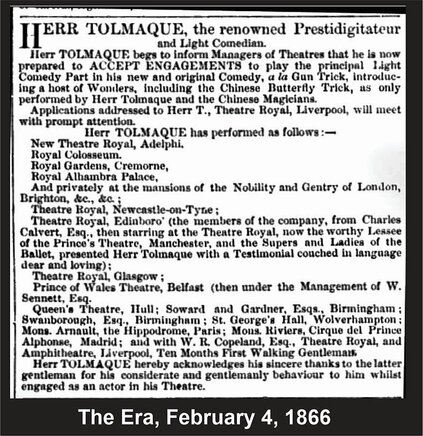
In the same run of advertisements, the Irish actor, William B. Cahill (1) is said to have adopted the performance of Tolmaque’s ‘Amplifico dancing figure’; Cahill was performing in Liverpool in the role of Pantaloon during February 1866. This advertisement was a puff-piece to assist in the search for new engagements, but of those facts that may be checked, all are confirmed.
Tolmaque mentions a new trick, ‘The Chinese Butterfly Trick’ which is more often associated with Japanese performers whose performances were becoming all the rage in Britain. (2) The Butterfly trick was a feat in which paper butterfly shapes were manipulated to ‘fly’ above a hand-held fan; even allowing for the fact that the butterflies were tethered by fine threads, it was a difficult and skilled routine.
Martin Tolmaque remained in Britain for the next decade, and from what can be discovered of his life until 1875, his career fluctuated wildly from peaks of success to the depths of insolvency. Now in his thirties, he became unquestionably a talented performer, capable of holding an audience for a full evening, and he appeared before the upper levels of British society; but he is seen at the next moment trudging on foot from town to town, and giving penny shows for school children wherever he can manage to scrape up an audience. The explanation for his varied fortunes comes from ‘The Struggles of Life’ in Chapter VI:
“Various were my fortunes after this. Sometimes up, and more frequently down, in the world. I fought the battle of life with all my heart, with all my strength. I purpose now to give my readers some slight insight into the shifting scenes of a wandering showman’s life, how one day such an one may be called upon to entertain the high born of the land, and the next may find him on the lowest rung of the ladder, that is, provided a person at all resemble your humble servant, whose greatest misfortunes through life have arisen from an utter lack of talent for business, or the dry details of a money grubbing career who, always lavish with his money will ride in his carriage, and live en prince, utterly insensible to the fact that a man living on his capital, and even exceeding that, must eventually come to ruin.
Heaven forbid that I should make a boast of it; nay, I am duly sensible of the shame attached to any such admission as I am about to make, but I take a pleasure in this self-imposed duty, if only as a warning to future aspirants. Many a time and oft, have I earned an income of forty, and even fifty pounds a week, and spent at the rate of nearly double that amount. Now that age and experience, bitter, bitter experience, has at length opened my eyes to the value of pounds shillings and pence, I look back with almost horror at the idea of earning 180 pounds in a night by a benefit given to me in London, and finding myself a week afterwards wandering about almost without the wherewithal to purchase the common necessaries of life. Of course there was no reason for all these hardships and shift if - that little word - if - if I had only the common prudence to lay by for a rainy day, but then, you see I haven’t common prudence, and I did not lay by for a rainy day, and that makes all the difference.”
And Chapter VII: - “Walking was a great hobby of mine, especially in the country and in lonely places, for then I could give full reign to my imagination, and to play Shakespeare or perform magic before crowded and delighted audiences.”
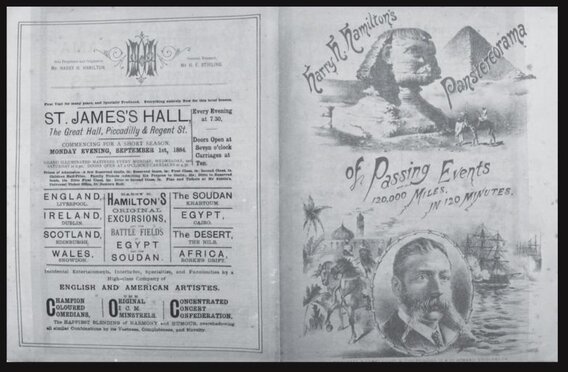
By 1866 the Davenport Brothers had gone off to fill their pockets in Ireland and Scotland, Immediately followed by Germany, Belgium, Holland, and Russia. The spirit manifestations remained in Tolmaque’s repertoire along with his Indian Rope Feat, but after his flurry of public notoriety, little is seen of him as a magician during the years 1866-1868. It might be assumed that he was still performing for private audiences – in fact in Chapter XIV he mentions having performed in 56 different establishments during a season, but for some months in 1868 he became a ‘tour guide’; not of the travelling kind, but a narrator for a grand panoramic exhibition. Mr. Joseph Hamilton, with his brothers William, Harry H., and Alfred, had operated a prominent travelling Panorama company since 1848. He advertised his ‘Continental Excursions’, an exhibition of scenes from Paris, Pompeii and Rome, taken from sketches made during his last tour on the Continent. “Mr. Tolmaque will accompany the Party as Guide, and give interesting descriptions of all the places of note on the Tour; and, in order to render the journey agreeable, Grand National Music will be performed by the band.” Tolmaque was seen as far afield as Stockton-on-Tees and Worcester. By October 1868 he was advertising his availability for Christmas performances, ‘Two Hours with Herr Tolmaque’, from the address 8 Garden-street, Bury in Lancashire.
As of January 1869 he was still with Hamilton’s Excursions, in Merthyr Tydfil (Wales), but in February he advertised that ‘the renowned wizard’ was about to visit Oswestry, Welshpool, Newtown, Wem and others, making Chapel House, Hill’s Lane Shrewsbury his headquarters for a month or more.
By July Martin was promoting a week’s appearance in Hull during August, but it seems that he was unable to secure a hall, and he makes reference (Chapter XXIII) to having gone off to Germany, where he remained for only three weeks, and on his return to Britain he ventured North to Alnwick. That remark places his German trip as being in August 1869.
Career Highlight in Alnwick
Tolmaque was at Alnwick in Northumberland, north of Newcastle on Tyne during mid-September 1869, where he was resident at the Corn Exchange. (3) “The celebrated professional conjuror, Herr Tolmaque has been giving a series of highly amusing and successful performances in the Corn Exchange building during the past week. Large and applausive audiences filled the Exchange on successive nights, and were greatly entertained by the dexterous feats of the clever prestidigitateur … he exhibited the ingenious Japanese butterfly trick, and other feats of legerdemain, too numerous to be particularised, but all in the highest style of conjuring.”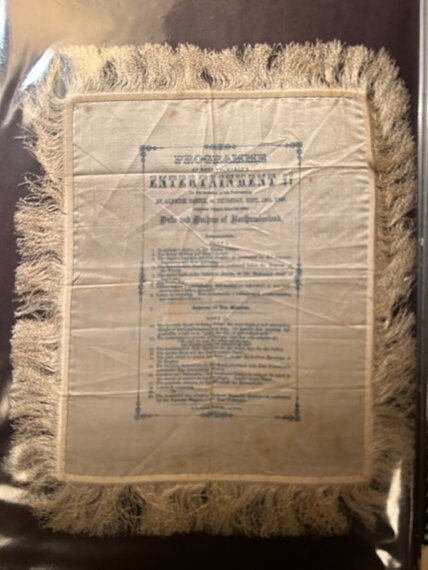
On September 16, Herr Tolmaque was honoured by an invitation to perform at Alnwick Castle, before their graces the Duke and Duchess of Northumberland (4). A lavish fringed silk programme was produced for the occasion, one of which still exists in the collection of magician Ken Trombly.
This performance was the highlight of Tolmaque’s career to date, and such was his pride in the event, he would head many of his advertisements, and his later newspaper articles with the phrase “By Special Appointment to His Grace the Duke of Northumberland”; truthful, if somewhat inflated.
Silk Programme for performance at Alnwick Castle,
September 16, 1869 - Ken Trombly collection
Introduction
PART I.
1. Everybody’s choice, or, Die Karten Voltige
2. The flying Shilling and Magic Goblet.
3. The original Japanese printing illusion – as performed by the Japanese Magicians and Herr Tolmaque.
4. The indestructible Handkerchief – as performed before the Empress of the French.
5. The aerial flight of the Casket of Jewels, or the Enchanted Scarf of Cagliostro.
6. Egg versus Hat.
7. Dexterological Prestidigitation and mysterious restoration of two half crowns and a lady’s mouchoir.
8. Lesson in conjuring. How to mesmerise a Walking Stick, a most amusing and instructive illusion.
9. Interval of Ten Minutes
PART II
10. The invisible Bank, or flying Coins; the most finished and astounding sleight of hand performance ever seen. To describe this seeming impossibility would be to “paint the lily, or gild refined gold.”
11. The instantaneous growth of Flowers – this feat will surprise all. “The rich, the poor, the valiant and the sage, And boasting youth, and narrative old age.” (5)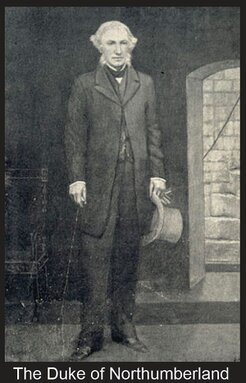

12. The inexhaustible Hat – Bonbons for the ladies, toys for the babies.
13. The mystic Ring and the Pastry-cook’s Puzzle.
14. The card which no person can destroy, or the Mysterious Envelope of Dr Faustus.
15. The invisible Hen and productive Scarf, combined with Herr Tolmaque’s celebrated Egg diminishing illusion.
16. Junction and disjunction; this wonderful illusion is without its equal in the annals of ancient or modern magic. Candle versus Paper.
17. The cabalistic oranges, or Die Silberluft der Hexenküche
18. Lesson in conjuring.
19. do.
20. The wonderful and pleasing Japanese Butterfly Illusion – as performed by the Japanese magicians and Herr Tolmaque.

He moved on from Alnwick to Morpeth and Blyth; but he ran into a problem in which he would allege that the Central Hall had been let to another person, after he had already engaged the venue. The case came to court and damages of £19 were to be claimed for breach of contract – but on the case being called, Tolmaque had withdrawn at the last moment, and His Honour assigned costs against him. Martin moved on and in late November gave an entertainment on board the Wellesley Training Ship at South Shields, attended by the Mayor who complimented the conjuror on his “tricks, all in the highest style of conjuring without apparatus of confederates, and gave the greatest satisfaction to all present.” He was seen at South Shields New Theatre Royal in mid-December, and ended the year at the Royal Music Hall in Southport. It is possible that he settled around the Newcastle region, where he is mostly seen during 1870, then appearing in 1871 at various venues in and around Liverpool, including the Lord Nelson-street Concert Hall, Queen’s Hall, and the Prince of Wales Theatre, with his “celebrated entertainment of Natural Magic and Ambidextrous Prestidigitation, entirely without Mechanisms or Paraphernalia.” In October of that year, Tolmaque went up to Scotland, appearing at Greenock Theatre Royal, then across to the Queen’s Royal Theatre in Dublin.
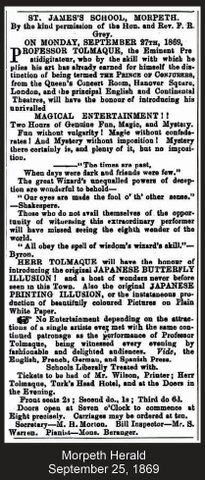
Acting as a witness in a court proceeding at Chester, he was mentioned as being an agent for Miss Johana Prichard, of whom nothing is known. However, since he is also mentioned six months later (5) as a Business Manager for Mr. Edwin Romaine, it appears that Martin was trying his hand at theatrical management.
1872 saw Tolmaque back at North Shields, at the Albion Assembly Rooms. ‘The Era’ had reported on January 28 that his entertainments, with Mr Wyndham (comic vocalist) were before “large audiences”. The lie was given to this report, however, when in February Mr. Wyndham sued for the recovery of £8 due to breach of engagement. Tolmaque was not the defendant in this action, but the defendant Mr. Crocker was claimed to be in partnership with Tolmaque, whose name was dragged through the mud during testimony.
Wyndham had come to give three concerts at the Albion, but on the third night the circumstances of the company were reduced to the position of the ‘manager in distress’. Tolmaque had not put in an appearance, and all money was returned at the door. Herr Tolmaque’s bill posters gave evidence that the magician had not ‘squared up’ his account on a former occasion, and they would have no more to do with Tolmaque because they “thought him not a safe man”. The magician was now absent, performing in Birmingham. Despite Mr. Crocker’s denials of being in partnership, the Judge sympathised with him but gave the verdict against Crocker. Herr Tolmaque continued on his way, and is last sighted performing magic in March, at the Theatre Royal, Coventry.
During 1873 Tolmaque is seen infrequently, appearing at Hull in August, Brigg in September (“an exhibition of performing dogs which, in conjunction with an interesting entertainment by Herr Tolmaque, has attracted large numbers to the Oddfellows’ Hall, Barton-on-Humber ... entertainment will be given at the Corn Exchange, Brigg, tonight.”), and a comment from a performance in Caistor in early December, that “some experiments in mesmerism (the only novelty in the programme) were entirely left out, to the complete disappointment of rather a large company.” From his memoir (Chapter XXIX), it seems that comical mesmeric performances had begun to form a large part of his repertoire.
Final Seasons in Britain
To piece together Martin Tolmaque’s final year or so in Britain, is it necessary to combine his memoirs with any available newspaper documentation. In February 1874, ‘The Era’ advertised that Mr. Washington Davies “late of Dr. Lynn’s” intended to commence a tour with Herr Tolmaque, one of the cleverest Conjurors in Europe, in the course of a week or so. Davies, contactable via the Egyptian Hall in Piccadilly, is not a well-known performer, but he appears to have promoted himself as a “scientific conjuror” and was more of a demonstrator of the sort of optical illusions and ghost spectacles which might be seen at the London Polytechnic. He is seen in England and Ireland as early as 1863 with the ‘Ghost’ illusion. In the event, there is little sign that the proposed tour went ahead.From February 14, 1874, Tolmaque was playing a double bill of magic, alongside one of the big new talents of magic, Alfred Silvester, the ‘Fakir of Oolu’.
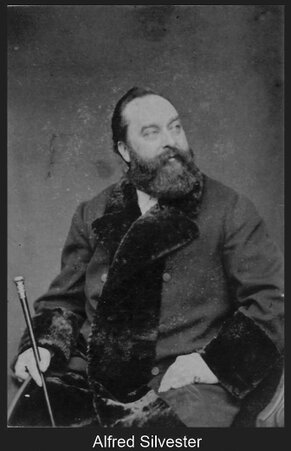
Silvester had started his performing career in the 1860s by making some useful improvements to the famous ‘Pepper’s Ghost’ illusion and, following tours of the United States as a magician, he had introduced ‘The Entranced Lady’, his presentation of Jean Eugène Robert-Houdin’s illusion, ‘La Suspension Ethéréene’ in which a young lady was lifted horizontally into the air, where she remained, supported by only a slender rod under one arm. By 1874 Silvester had discovered a way to remove the rod completely (‘The Last Link Severed’) and was performing a number of grand illusions, many making use of the mirrored glass principle from the ‘Sphinx’ illusion. His ‘Anoetos the Incomprehensible’ illusion featured a living severed head in a scripted theatrical sketch.
The Silvester / Tolmaque combined programme was featured at the Grand Concert Hall in Brighton, and in an extensive advertisement (6) Tolmaque uses a quote from ‘Punch’ magazine: “The great Basilikon Thaumaturgist double-handed lmarian Trompydeceillst Exmacaaistical Delusoriat Aamodean Pseudogorgous and Polyglot Professor”. He was featuring a pseudo-spirit trick, the Blood Writing on the Arm, in imitation of the spiritualist Charles H. Foster; and whether Tolmaque was the originator, or had been taught the effect by Silvester, both performers would continue to present the Blood Writing for years to come. The same advertisement mentions Herr Tolmaque as having performed at “The Lord Mayor’s Banquet at the Mansion House, and before the Royal Family at Cambridge House.”
Chapters XXXI and XXXII have Tolmaque performing at the military town of Aldershot, which may have been back in 1873, as he writes, “Here I remained ten months, during which time I had the superintendence and management of several of the so-called Garrison theatricals.” By April 1874 and through to July he was advertising in The Era as being ‘at liberty’, with his address shown as 3 Gladstone-Terrace, Aldershot. According to his memoir, he then had several months until his next London season, and spent the time “perambulating London in search of characters for my sketchbook”, some of which he later included in “The Struggles of Life”.
Coming into 1875, we must take Martin Tolmaque at his word, that “My last season in London was the most brilliant of all my successes. I was booked three deep some weeks before the actual commencement of the season, and had the honour of receiving invitations from nearly one hundred families of distinction.” Accepting this as the truth, he has two interesting advertisements in early January, which indicate his great success but at the same time state that he was open to engagement.
London and Provincial Entr’acte, January 16, 1875 – “Herr Tolmaque, Prestidigitateur and Humorist. By Special Appointment to his Grace the Duke of Northumberland, September 16th, 1869; the Lord Mayor of London, January 22, 1874; the Earl of Egmont, December 29th, 1874; and the Nobility and Gentry everywhere. Herr Tolmaque can now book dates, and will be glad to receive offers for his entirely New Entertainment. Gorgeous and Glittering Apparatus, Brilliant Illuminations, Ebony and Gold Tables and Chairs, Floral, Crystal, and other Handsome Picture Posters, Sensation feats, Marvels of Magic, Endless Amusement, always without the least vulgarity. A Gentleman and an Artist. Wanted, a respectable, sober Young Man, to look after Baggage, and act as Valet. Letters only to “Entr’acte,” office 5, Catherine-street, Stand, W.C.”
The Entr’acte, January 23, 1875 – “Herr Tolmaque Prestidigitateur and Humorist to His Grace the Duke of Northumberland, Sept. 16th, 1869.
The Earl of Egmont, Dec. 29, 1874.
The Lord Mayor of London, Dec. 31st, 1874.
Rear Admiral Luard, C.B., Dec. 31st, 1874.
M. De Gessier, Jan. 2nd, 1875
Major Trench, M.P., Jan. 4th, 1874.
The Nawab Nazim of Bengal and Prince Ahmed Khan, Jan. 22nd, 1874.
The Vicar of St. Clement’s Danes and other Distinguished Clergy, Jan. 6th, 1875.
Greenwich Hospital, Dec. 30th, 1874.
Chelsea Hospital, Jan. 5, 1875, before the Governor of the Hospital, Sir Patrick Grant, Lady Grant, Col. Gall, Capt. Irby, &c. &c.
The Right Honourable J.G. Dodson, M.P., Dec. 30th, 1874.
And the Nobility and Gentry everywhere.
HERR TOLMAQUE. In answer to numerous applications for this artiste’s services, he begs to inform his various correspondents that he cannot leave Town at present, several Noblemen and Gentlemen having retained him to teach them the real Art of Natural Magic – a Science and a Study to which Herr Tolmaque is devoted.
HERR TOLMAQUE – Notice to whom it may concern. A New Manifestation, entitled ALGORISM will shortly be heard of in the London Drawing Rooms….
HERR TOLMAQUE at the close of the London Season, Theatre Royal, Oxford. By kind permission of the Rev. Vice-Chancellor and the Right Worshipful the Mayor.”
In the face of what seemed to be enormous success, Herr Martin Tolmaque took the obvious next step. He packed his bags and sailed across the world to Australia, never to return.
References for Chapter Three
(1) William B. Cahill was born in Ireland and was seen in prominent roles in numerous plays including ‘The Forty Thieves’. He toured the United States in the 1850s with the famed Lydia Thompson Troupe. He was paralysed by a fall around 1900 and died in August 1906.(2) View a performance of the traditional Butterfly Trick at: https://www.youtube.com/watch?v=pjyInDQlWtY
(3) Alnwick Mercury, September 18, 1869
(4) The Duke of Northumberland - Henry George Percy, 7th Duke of Northumberland (1846 – 1918), Earl Percy was a British Conservative politician.
(4) More correctly “The poor, the rich …” Quoted from ‘The Temple of Fame’ by Alexander Pope (published c.1714)
(5) The Era, June 2, 1872, Prince of Wales Theatre, Wolverhampton. Edwin Romaine Callendar (1845-1922)
(6) Brighton Gazette, February 28, 1874.